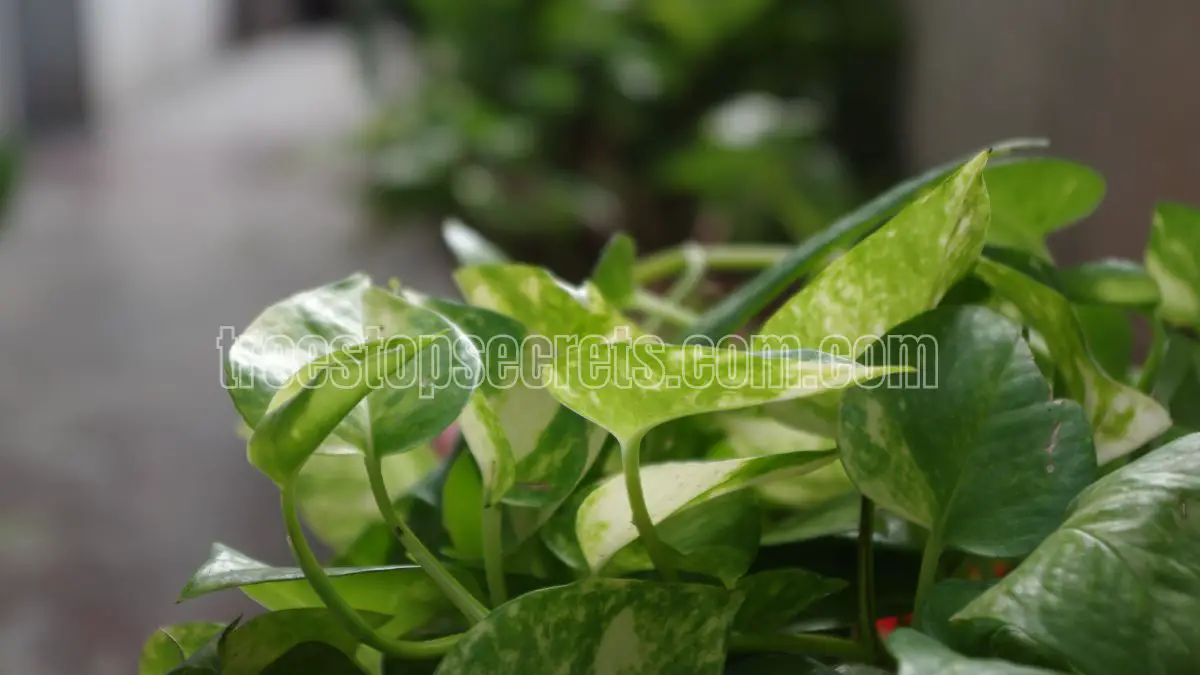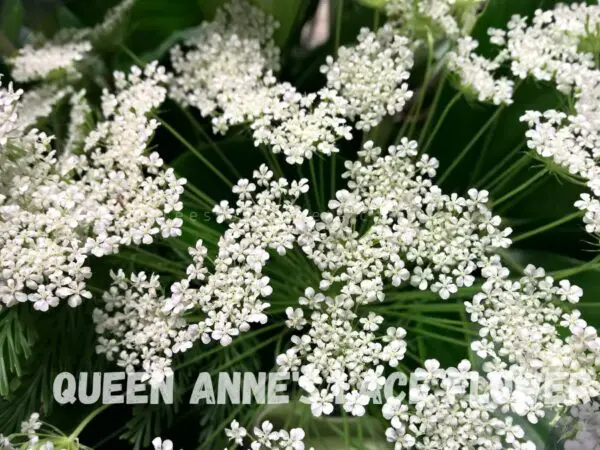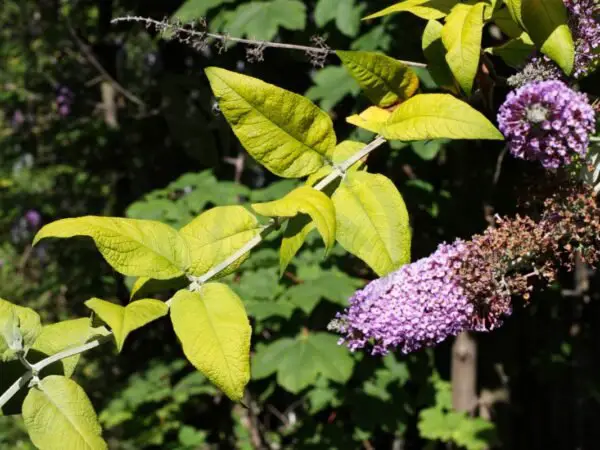Indoor money plant care is important to maintaining this beautiful, popular houseplant for many years. Renowned for its air-purifying properties and low-care nature, the money plant—or pothos—will thrive in all light levels.
To grow money trees successfully indoors you need to give them the proper levels of light, water, and humidity. Pruning regularly will keep it in shape and make it grow bushier. Knowing common pests and diseases can help you avoid them before they ever arrive.
This guide will cover key aspects of caring for your indoor money plant, from watering schedules to suitable pots, helping you create a vibrant and lively indoor space.
Key Takeaways
- Get in the habit of checking your money plant’s soil moisture so you can learn when it needs watering. Avoid overwatering by ensuring you use pots with drainage holes.
- Place your money plant where it will get at least 6 hours of indirect sunlight each day. If you’re still lacking natural light in the winter months, try adding grow lights.
- Select a quality soil blend with good drainage and high in peat moss. Keep the pH level between 6.0 and 7.5 for best growth.
- Be mindful of the fact that plants respond differently in summer and winter. Water more and fertilize more in the growing season, then reduce in fall and winter.
- Pay attention to indoor humidity levels, especially in arid areas of the country. Consider using humidifiers or plant grouping to increase the humidity levels in your environment.
- Keep an eye out for indications of insect and disease issues. Act quickly to correct any problems with organic remedies and routinely examine your plants.
Comprehensive Care Guidelines
Proper care of indoor money plants, particularly the popular Money Tree (Pachira aquatica) and Chinese money plants, requires a nuanced understanding of their specific needs. This section provides some basic money plant care tips to follow for watering, light exposure, soil choice, and seasonal changes. Stick to these guidelines, and your plants will be happy and healthy!
1. Understand Watering Needs
Watering is arguably the most important detail of indoor plant care. As a tropical plant, the Money Tree likes a moderate amount of watering. Signs indicating it's time to water include:
- Dry topsoil
- Drooping leaves
- Yellowing leaves
Overwatering is a leading cause of root rot and regularly monitoring the soil moisture will avoid this pitfall. Just use your finger to push down about an inch into the soil; if it’s dry, then it’s time to water.
Make watering less frequent, but more thorough. The watering schedule should change with the seasons. During spring and summer, the plant’s growing season, you’ll need to water more often. In fall and winter, when growth slows, the plant isn’t using as much water, so it needs less.
Choosing pots with holes in the bottom is key. This helps prevent water from pooling at the bottom, which can cause root rot. The most important thing is to observe how the plant responds to your watering changes to figure out the best frequency for your specific situation.
2. Optimize Lighting Conditions
Money Trees, a popular houseplant, thrive in bright, indirect light for at least six hours daily. Understanding the type of light available in your home is crucial for optimal money plant care. For best results, position the plant by a window that provides this bright, indirect light, or in a well-lit room away from direct sunlight. If natural light is limited, especially during winter, consider using grow lights to enhance ambient light and support your plant's growth.
To promote even money plant growth, turn your Money Tree every few weeks, ensuring that each side receives equal light. This practice prevents the plant from stretching towards the light source, which can lead to an unsightly, lopsided appearance. Proper maintenance is essential for keeping your Money Tree healthy and attractive.
With the right care, your Money Tree can flourish, contributing to the prosperity and abundance in your home. By following these guidelines, you can enjoy a beautiful plant that enhances your living space while bringing good fortune.
3. Choose the Right Soil Mix
Choosing the right soil mix is crucial for your Money Tree to thrive. An ideal potting mix should include:
- Peat moss
- Perlite
- Compost
This mix helps ensure that your trees have the nutrients they need, without compromising drainage. Money Trees need a loose, well-draining soil to allow roots to grow properly with no chance of stagnant water that causes root rot.
It is good practice to test the soil pH regularly as well. Money Trees thrive with a pH of 6.0—7.5. Wastewater pH should be between 6.5 and 8.5. If not, amendments will need to be added to bring the pH to the proper level.
4. Adjust to Seasonal Changes
Understanding seasonal changes is crucial for effective money plant care, especially for your Money Tree. During spring and summer, when the money tree plants are actively growing, it's essential to adjust your money plant watering schedule since they require more water during these vibrant months. Conversely, as fall and winter approach, the plant enters a dormant phase, necessitating a gradual decrease in both watering and fertilization.
Additionally, monitoring the light conditions is vital as the seasons shift. If you notice that natural light diminishes, it may be necessary to relocate your money tree to a sunnier spot to ensure its continued growth. This attention to care can help maintain a healthy and thriving money tree, contributing to your indoor garden's prosperity.
By observing these seasonal changes, you can foster new growth in your money tree plant, ensuring it remains a great addition to your collection of popular houseplants.
5. Manage Indoor Humidity Levels
Keeping humidity high is ideal for Money Trees, particularly in more arid conditions. Indoor humidity levels should be kept above 30%. To address this, you might try a humidifier.
Alternatively, you can increase the humidity around your plants by clustering them together in a microclimate. Misting the leaves on a regular basis will raise humidity levels without the dangers of overwatering.
This practice allows you to recreate the plant’s native habitat, which is often much more humid.
6. Use Organic Fertilizers Effectively
Organic fertilization plays an especially important role during the growing season, usually defined as spring through summer. It’s best to fertilize once a month with a diluted all-purpose organic fertilizer.
Signs that indicate when to fertilize include:
- New leaf growth
- Pale leaves
If all that fertilizer gets reduced to salt, it will build up in the soil and potentially burn the plant. For this reason, it is crucial that you do not exceed recommended application rates.
7. Recognize Early Pest Signs
By making a habit of inspecting your plant regularly, you can identify the presence of pests much earlier on. Mealybugs and scale are common pests that can target Money Trees.
Symptoms to look for include:
- Sticky residue on leaves
- Webbing on the plant
As soon as you see any signs of activity, use the least toxic insecticide or horticultural oil available to eradicate the infestation. Catching the problem early will help keep your plant from suffering long-term effects.
8. Identify Common Diseases and Solutions
Recognition of disease as it occurs is key to prevention. Yellow or brown leaves are a common sign of overwatering or underwatering. Look for soft stems or trunks to rule out root rot.
When you do, don’t hesitate—repot your plant into new, dry soil ASAP. Common diseases like fungal infections are a side effect of the stress. Solutions can include applying fungicides or increasing air flow around the plant.
As a rule of thumb, always make sure that the plant has excellent drainage to avoid such problems.
9. Explore Advanced Propagation Techniques
Money Trees are quite easy to propagate through stem cuttings, preferably in spring or summer. To propagate successfully, follow these steps:
-
Take healthy stem cuttings, ideally 4-6 inches long.
-
Root the cuttings in water or directly into a potting media.
-
Once roots develop, pot the cuttings in suitable soil.
Trying out new propagation techniques will not only grow your indoor plant collection, but can offer a deeply rewarding experience.
10. Integrate Smart Technologies
With so many smart technologies available, adopting them can make a huge difference in how you care for your plants. These smart devices can even track soil moisture and light levels, making sure your Money Tree gets the best care possible.
Scheduling watering and fertilizing reminders based on your plant’s unique needs can make plant care more efficient. Look for apps that provide personalized care advice and let you monitor your plant’s progress over time.
With this technology, you will gain a deeper understanding of your plants’ needs and enjoy a flourishing indoor garden.
Indoor Plant Care Services in California and Texas
Indoor plant care services are the key to beautiful, healthy plants that improve homes and workplaces. This hold is particularly acute in California and Texas, where these services flourish. These services offer education on plant care, pest control and design services.
They’re uniquely suited to local growing conditions, which means that indoor plants are well-adapted to their environments.
1. Reputable Services in California
- The Plant Stand: Specializes in plant rentals and maintenance for corporate spaces.
- Green Thumb: Focuses on eco-friendly practices, offering organic plant care solutions.
- Los Angeles Indoor Plants: Offers customized care plans and design services for homes.
Most indoor plant care customer reviews will focus on responsiveness and courtesy of service staff. Companies like Green Thumb offer customized plans that consider the specific needs of popular houseplants, including pilea plants and money tree plants, while aligning with client goals.
2. Notable Services in Texas
- Texas Plant Rentals: Offers both residential and commercial plant rental services.
- Eco-Friendly Greens: Specializes in sustainable plant care practices.
- Indoor Oasis: Provides educational workshops on plant maintenance.
Services are tailored to a wide range of clientele, focusing on education in addition to money plant care.
3. Offerings and Expertise of Local Services
| Service Provider | Specialties | Expertise Areas | Pricing Structure |
|---|---|---|---|
| The Plant Stand | Plant rentals, design | Pest management, maintenance | Monthly subscription basis |
| Texas Plant Rentals | Residential and commercial | Plant design, educational resources | Custom quotes available |
Plants require routine watering, adequate light, and at least once-a-month fertilization during the growing season to thrive. Proper money plant care, along with regular pest monitoring and repotting, will lead to a beautiful pilea.
Common Challenges and Solutions
Indoor plant care, especially for money tree plants, comes with its own set of challenges that owners need to be aware of. Proper money plant care can help to improve the health and longevity of these great plants.
1. Urban Environment Impacts
Restrictive urban environments can further cut down on available light and degrade ambient air quality, making it difficult to grow healthy plants indoors. Plants such as money trees, which prefer bright, indirect light, would not do well in areas that lack natural light.
To combat these challenges, owners should try positioning their plants close to windows or using grow lights. Adding indoor plants that purify the air, like peace lilies and snake plants, is another way to boost indoor air quality.
- Urban-friendly plants:
- Pothos
- ZZ plant
- Spider plant
2. Climate-Specific Issues
California and Texas come with their own set of climate challenges, such as high humidity and rapid changes in temperature. Money trees like high humidity but will do fine with average household humidity if they are given extra attention.
Choosing more climate-resilient varieties that need lower levels of upkeep can help. Make seasonal care changes, like misting during dry seasons, to keep the environment in tiptop shape.
3. Creative Solutions for Common Problems
Creative technology makes it easier to cultivate greenery within our homes. Self-watering pots prevent overwatering, one of the most common and deadly mistakes that lead to root rot.
By strategically placing plants and proactively pruning, you can create something that looks good and keeps plants thriving. These techniques encourage vigorous shoots while keeping the plants shapely.
- Insecticidal soap
- Neem oil
Conclusion
Providing proper indoor money plant care can fill your home with life and beauty and transform your environment. By adhering to the instructions outlined in this article, you’ll be well on your way to ensuring your plant stays vibrant and healthy. From watering to light conditions, every detail contributes to the overall success of your money tree.
If you struggle, know that there are ways to be successful. Contacting your local plant care services in California or Texas will give you personalized assistance. So take the time to appreciate the art of indoor gardening, and see your plant thrive.
Begin your adventure in indoor plant care and make your home a greener, more colorful place.
Frequently Asked Questions
What is a money plant?
What is a money plant? The money plant, commonly known as Pothos, is a popular houseplant admired for its beautiful heart-shaped leaves and air-purifying properties. This resilient foliage houseplant is easy to grow and thrives in various lighting conditions.
How often should I water my money plant?
To ensure proper money plant care, let the top inch of soil dry out between waterings; overwatering can lead to root rot in your money tree plant.
What type of light is best for money plants?
What kind of light do money plants, including popular varieties like the chinese money plant, like the best? Keep out of the harsh rays of the sun, which will burn the leaves. Additionally, they do well in low-light environments.
How do I fertilize my money plant?
To ensure healthy money plant growth, fertilize your money plant every 4-6 weeks during the growing season (spring and summer). The best way to fertilize these popular houseplants is to use a balanced liquid fertilizer diluted to half strength.
What if my money plant's leaves turn yellow?
If yellow leaves appear on your money plant due to overwatering, you should notice your plant’s leaves yellowing and falling off. Adjust your money plant watering schedule accordingly if the soil is too dry or not dry enough, or consider relocating the plant to an area with more light.
Can money plants grow in water?
Can money plants, specifically the popular chinese money plant, grow in water? Just put the stems in water, ensuring that the nodes are submerged. Change the water every 2 weeks to avoid stagnation.
Are money plants toxic to pets?
Are money plants toxic to pets? Yes, money plants, including popular varieties like the chinese money plant, are mildly toxic to cats and dogs if ingested. To ensure the safety of your pets, keep these beautiful pilea plants out of their reach.
Image Source: Paid image from CANVA




